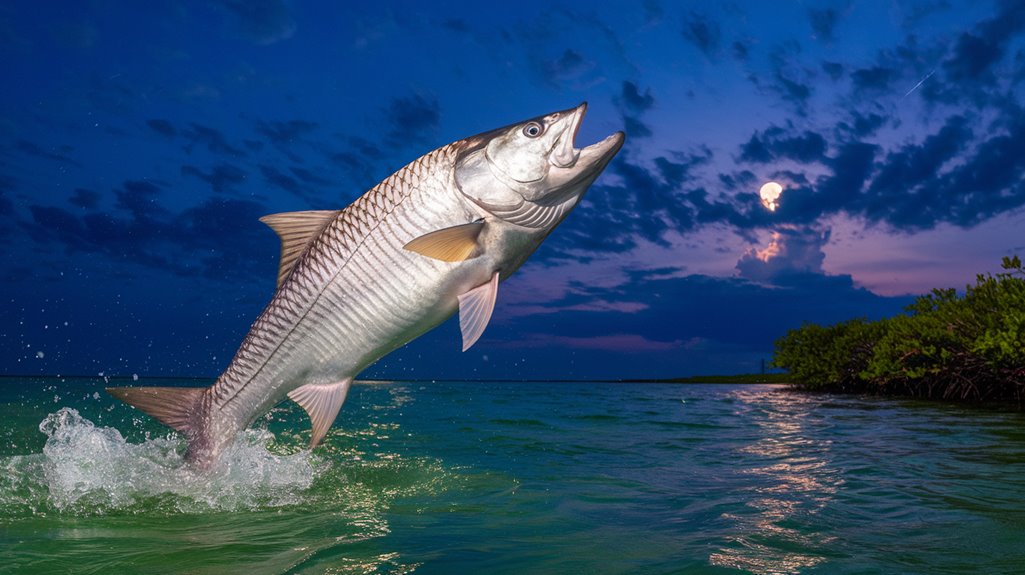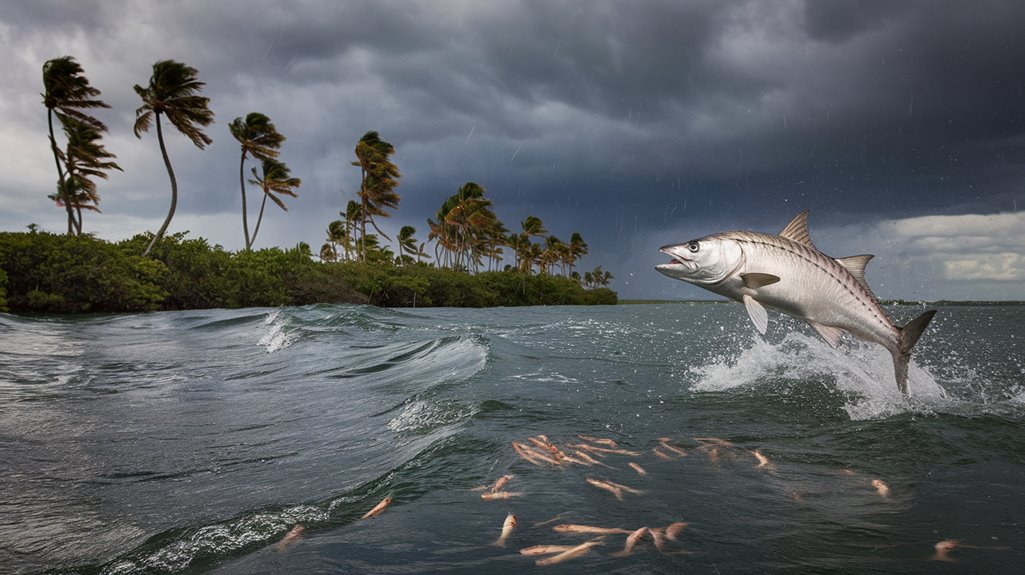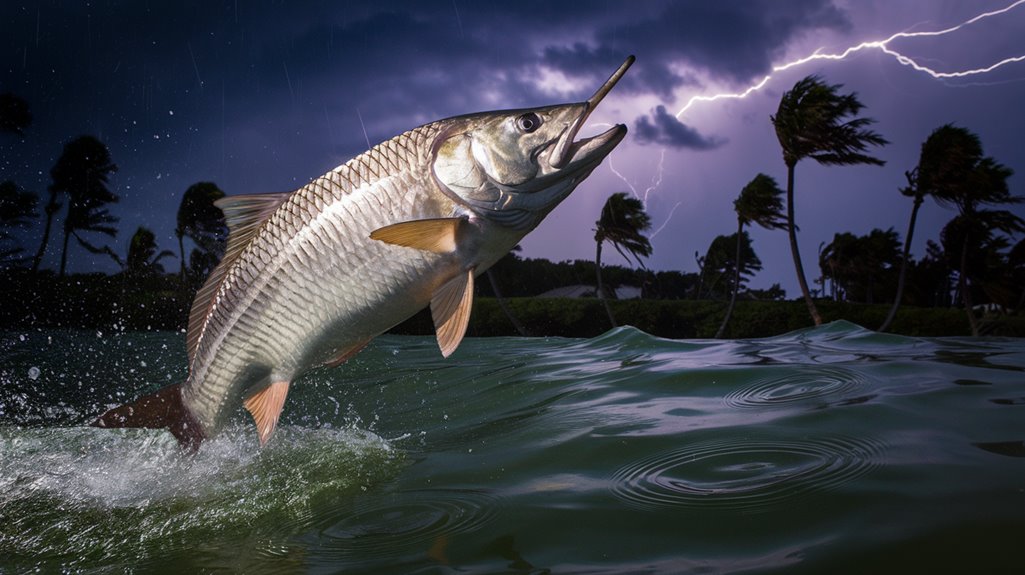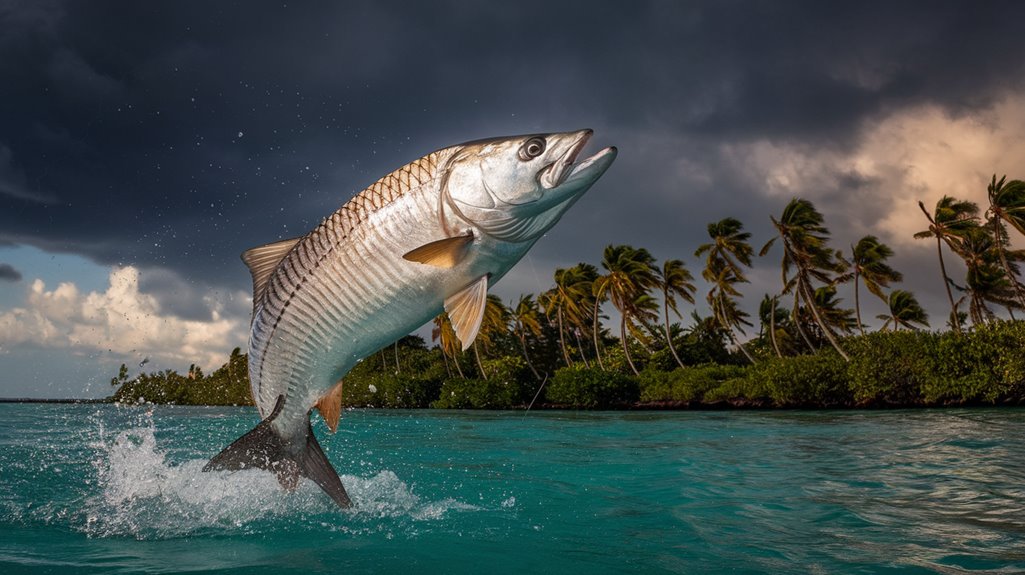When you're targeting tarpon, weather conditions can make or break your fishing success. You'll find these majestic gamefish are highly sensitive to atmospheric changes, from subtle barometric shifts to dramatic weather fronts. Understanding how tarpon respond to specific conditions – including water temperature, moon phases, and wind patterns – puts you ahead of other anglers. Let's examine the key weather factors that'll help you predict prime fishing windows and increase your hookups.
- Key Takeaways
- Moon Phases and Tidal Influences on Tarpon Movement
- Understanding Barometric Pressure Changes for Better Catches
- Wind Patterns and Their Impact on Tarpon Feeding Habits
- Water Temperature Ranges for Peak Tarpon Activity
- Storm Systems and Weather Front Effects on Fishing Success
- Prime Seasonal Weather Conditions for Targeting Tarpon
- Frequently Asked Questions
- Conclusion
Key Takeaways
- Tarpon become most active and aggressive when water temperatures are between 75-88°F, making these conditions ideal for fishing.
- Barometric pressure between 29.8-30.2 inches Hg creates optimal fishing conditions, with sudden drops triggering increased feeding activity.
- Full and new moon phases produce stronger tides, concentrating tarpon near creek mouths and deeper channels.
- Light to moderate winds enhance surface disturbances and maintain oxygen levels, creating better fishing conditions.
- Monitor weather patterns, tides, and pressure simultaneously to identify peak fishing opportunities and adjust strategies accordingly.
Moon Phases and Tidal Influences on Tarpon Movement

When you're planning your next tarpon fishing expedition, understanding lunar patterns can dramatically improve your success rate. Full moon and new moon phases create stronger tidal movements that trigger increased tarpon activity, making these periods prime fishing conditions. During these phases, you'll notice heightened feeding patterns as baitfish get pushed into shallow waters by amplified currents.
You'll find exceptional opportunities during full moons, as the increased light promotes aggressive nighttime feeding. During new moon phases, focus on daytime fishing around creek mouths and passes when tide swings peak. To maximize your catch rates, align your fishing schedule with these lunar influences and corresponding tidal movements. By tracking moon phases alongside tide schedules, you'll position yourself for ideal tarpon encounters during their most active periods.
Understanding Barometric Pressure Changes for Better Catches
You'll find tarpon most active when barometric pressure readings stay between 29.8 and 30.2 inches of mercury during their migration patterns, especially after the pressure has stabilized for 72 hours. When you notice sudden pressure drops exceeding 0.18 inches within three hours, get ready for aggressive feeding behavior as tarpon respond to pre-storm conditions. Your success rate will improve by tracking pressure trends rather than single readings, as these fish tend to move from shallow to deeper waters when pressure extremes occur.
Pressure Patterns During Migration
Understanding barometric pressure patterns can greatly improve your tarpon fishing success during migration periods. When you're tracking weather conditions, focus on falling barometric pressure, as it often triggers aggressive feeding behavior. You'll find peak fishing when pressure readings fall between 29.8 and 30.2 inches Hg.
- Monitor rapid pressure drops (>0.18 inches Hg in 3 hours) to identify prime fishing windows
- Target deeper waters (>33 feet) during unstable pressure periods, as they provide more consistent action
- Track pressure trends ahead of your planned fishing dates to predict tarpon activity
For the best results, combine your pressure monitoring with strategic fishing spot selection. You'll notice that tarpon activity intensifies during pressure drops, making these periods ideal for targeting these powerful gamefish.
Reading Pre-Storm Fish Activity
Tracking barometric pressure changes before storms offers a significant advantage for tarpon fishing success. You'll want to monitor sudden drops, particularly when readings fall more than 0.18 inches Hg within three hours, as these conditions trigger aggressive feeding behavior.
Keep your eye on the ideal range between 29.8 and 30.2 inches Hg for the best fishing conditions. When you notice the pressure dropping, it's time to prepare – tarpon will increase their activity levels just before the storm hits. While readings below 29.8 inches Hg typically indicate poor fishing, monitoring trends rather than isolated readings is essential. After the storm passes, you'll find productive fishing opportunities as the pressure rises and tarpon return to shallower waters, resuming their normal feeding patterns.
Wind Patterns and Their Impact on Tarpon Feeding Habits

Wind patterns play an essential role in determining tarpon feeding behavior and success rates for anglers. Light to moderate winds create surface disturbances that enhance tarpon feeding by making baitfish more vulnerable. You'll find that east winds typically provide calmer inshore conditions, creating prime feeding opportunities for these predatory fish.
Key wind pattern effects on tarpon fishing:
- Surface agitation increases visibility and exposes baitfish
- Nutrient stirring in the water column triggers active feeding times
- Wind direction influences fish positioning and movement patterns
While strong winds can scatter baitfish, they'll also concentrate prey in specific areas, giving you targeted fishing zones. Understanding these wind-driven behaviors helps you adapt your approach during different conditions, maximizing your chances of success during peak tarpon feeding periods.
Water Temperature Ranges for Peak Tarpon Activity
You'll find that tarpon are most aggressive and active when water temperatures sit between 75 and 88 degrees Fahrenheit, creating prime feeding opportunities for anglers. Understanding these temperature-driven feeding zones can dramatically improve your success rate, as tarpon become significantly less active when temperatures fall below or rise above this ideal range. Your attention to seasonal temperature patterns will help you track tarpon movements and predict when they'll be most receptive to your presentations.
Optimal Temperature Feeding Zones
Understanding water temperature zones is critical for successful tarpon fishing, as these magnificent gamefish are highly temperature-dependent creatures. The ideal temperature range of 75-88°F directly impacts their metabolism and feeding activity, making it essential for you to monitor these environmental factors closely.
- Water temperatures below 75°F will greatly reduce your chances of catching fish, as tarpon become sluggish and less interested in feeding
- The sweet spot for successful fishing lies between 75-88°F, when tarpon's metabolism and food intake peak
- Above 88°F, you'll need to adjust your strategy as tarpon seek cooler, deeper waters to avoid stress
Seasonal Temperature Pattern Effects
Seasonal water temperature patterns create distinct windows of opportunity for tarpon fishing throughout the year. You'll find these fish most active when water temperatures range between 75 and 88 degrees Fahrenheit, making spring and summer prime fishing seasons.
Understanding these seasonal fluctuations is vital for your fishing strategies. As water temperature rises within the ideal range, tarpon become increasingly active, seeking baitfish in shallow areas during incoming tides. You'll need to adjust your approach when atmospheric conditions cause temperature changes, as these directly impact feeding patterns. When temperatures drop below 75 degrees, expect sluggish behavior and reduced feeding activity. Monitor weather patterns closely, as they'll help you predict tarpon movements and maximize your chances of success during peak seasonal periods.
Storm Systems and Weather Front Effects on Fishing Success

When storm systems approach coastal waters, tarpon behavior undergoes distinct changes that can considerably impact fishing success. You'll notice increased tarpon activity as barometric pressure falls, creating prime fishing opportunities just before the storm hits. Understanding these atmospheric conditions helps you optimize your angler strategies for better results.
- Track weather patterns and pressure trends to time your fishing trips when tarpon are most active
- Target areas where surface disturbances from light winds help tarpon locate prey
- Adjust your approach after storms by focusing on deeper waters where tarpon regroup
The key to success lies in adapting your tactics to these weather-driven feeding behaviors. You'll find tarpon become increasingly aggressive before storms, making these periods especially productive if you're positioned in the right locations with appropriate techniques.
Prime Seasonal Weather Conditions for Targeting Tarpon
Successful tarpon fishing depends heavily on identifying and leveraging perfect weather conditions throughout the season. You'll find the most active fish during full moon phases when stronger currents stimulate feeding behavior. Water conditions are ideal between 75-88°F, as temperature affects their metabolism and feeding frequency.
For perfect conditions, look for light to moderate winds that create suitable surface visibility while maintaining enough oxygen in the water. Monitor barometric pressure closely – dropping pressure before storms often triggers aggressive feeding patterns. Position yourself near creek mouths and deeper channels during strong tidal movements, where tarpon naturally ambush their prey. By combining these weather conditions with the right timing and location, you'll greatly increase your chances of a successful catch.
Frequently Asked Questions
How Old Is a 100 Pound Tarpon?
You'll find that a 100-pound tarpon is typically 10-15 years old, though growth rates vary based on environmental conditions and food availability in their habitat.
What Is the Best Tide to Fish for Tarpon?
You'll find tarpon most active during incoming tides when baitfish flood the shallows. During outgoing tides, target deeper channels where they ambush prey. Avoid slack tides when they're less active.
What Is the Best Barometric Pressure to Go Fishing?
You'll find ideal fishing when the barometric pressure ranges between 29.8 and 30.2 inHg, but you'll also experience excellent action during falling pressure, especially just before storms hit.
What Weather Factors Improve Fishing?
You'll find better fishing during strong tides, dropping barometric pressure, ideal water temperatures (75-88°F), light to moderate winds, and full moon phases that create stronger currents and feeding activity.
Conclusion
You'll maximize your tarpon fishing success by carefully monitoring key weather conditions. Track water temperatures in the 75-88°F range, maintain awareness of barometric pressure between 29.8-30.2 inches Hg, and align your trips with full and new moon phases. Don't forget to take into account wind patterns and approaching weather fronts. By combining these atmospheric factors with seasonal patterns, you'll greatly increase your chances of landing more tarpon.

